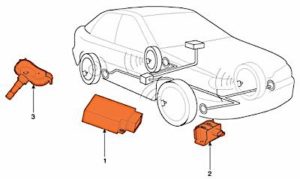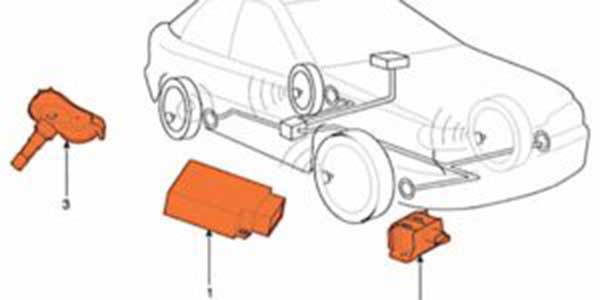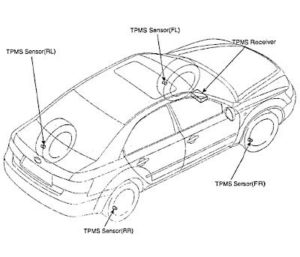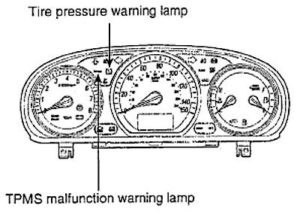Hyundai has equipped most of its vehicles with TPMS since the 2007 model year. Most Hyundai vehicles use systems from Lear, TRW or Continental. These systems have an auto relearn function. But if you are initializing a sensor or doing a manual relearn, you will need a TPMS tool that can capture the sensor IDs and program them into the TPMS module.
Most 2007-’10 models use clamp-on sensors. After 2010, most models were equipped with rubber valve stems that snap into the wheel.
Relearns
These systems do not require a relearn for tire rotation. Only one automatic relearn procedure will take place during a given ignition cycle.
The receiver will complete the relearn procedure after the vehicle is driven up to 20 minutes at speeds over 12 mph (20 km/h). Later systems require only 10 minutes at 15 mph. Check the service information for the specific speeds and times for the relearn procedure.

Identifying TPMS
sensor (3), receiver (1)
and initiator
components (2).
Corrected tire inflation pressure will cause the TPMS indicator to shut off once the tire pressure sensor reports to the TPMS receiver, approximately 20 minutes after the vehicle stops moving, or after 20 minutes of continuous driving.
Reprogramming
If a TPMS wheel sensor is replaced or the TPMS module is replaced, you will need a TPMS tool that can collect the sensor IDs and program them to the TPMS module via the OBDII port.
Hyundai recommends not performing initialization or reprogramming if the vehicle is parked on a metal floor, roof, or even on an alignment rack or lift. The metal will transfer the RF signals, which can cause the learn procedure to fail and set DTCs. In some cases where a sensor has failed, a system might pick up a sensor ID from another vehicle if it is driven nearby and has a similar sensor.
Diagnostics
Most models have a warning light for low inflation and a generic TPMS light for system performance. When low tire pressure or rapid deflation is detected, the low-pressure warning light on the instrument cluster will be illuminated. If the system detects a module, receiver or sensor fault, the TPMS warning indicator on the instrument cluster will be illuminated.
The early system had the warning lamps directly wired to the instrument clusters. Later models activate the TPMS lights using a serial data connection to the instrument cluster.
The main difference between high-line and low-line systems on some models is the use of an initiator module that transmits a signal telling the sensors to transmit. Some models have separate initiators for the front and rear sensors.
Most sensors are passive and transmit at specific intervals when the sensors detect motion. The sensor will not transmit unless requested to do so by the initiate command or when the vehicle accelerates to 20 mph (32 km/h).
Systems on 2007-’15 vehicles use the same data parameter as the cruise control for vehicle speed. The sensor is on the output shaft of the transmission. If the TPMS or cruise control is missing this data, it will cause a TPMS malfunction.
Even though Hyundai used different suppliers, the codes for the TPMS followed the same structure and nomenclature:
- C1121 Sensor 1 Battery Voltage Low
- C1122 Sensor 2 Battery Voltage Low
- C1123 Sensor 3 Battery Voltage Low
- C1124 Sensor 4 Battery Voltage Low
- C1126 TPMS ECU Battery Voltage Low
- C1127 TPMS ECU Battery Voltage High
- C1300 TPMS ECU IRX Not Responding
- C1312 Sensor 1 Radio Frequency Channel Failure
- C1313 Sensor 2 Radio Frequency Channel Failure
- C1314 Sensor 3 Radio Frequency Channel Failure
- C1315 Sensor 4 Radio Frequency Channel Failure
- C1322 Sensor 1 Over Temperature (Front Left)
- C1323 Sensor 2 Over Temperature (Front Right)
- C1324 Sensor 3 Over Temperature (Rear Left)
- C1325 Sensor 4 Over Temperature (Rear Right)
- C1332 Sensor 1 Fault
- C1333 Sensor 2 Fault
- C1334 Sensor 3 Fault
- C1335 Sensor 4 Fault
- C1345 Front Low-Frequency Initiator Channel Failure
- C1346 Rear Low-Frequency Initiator Channel Failure
- C1613 CAN Wrong Message
- C1616 CAN Bus Off
- C1660 Receiver Radio Frequency Circuit Failure
- C1661 Receiver EEPROM Failure
- C1662 Auto Learning Failure
- C1664 Initiator Left Front/Right Front Circuit Failure Not Affecting RSSI Level (High Line Only)
- C1665 Initiator Supply Circuit Short To Ground
- C1666 Initiator Supply Circuit Short To Battery
- C1668 Internal Failure Detection
- C2512-C2515 Lamp Open or Short. Article courtesy Brake & Front End.
















